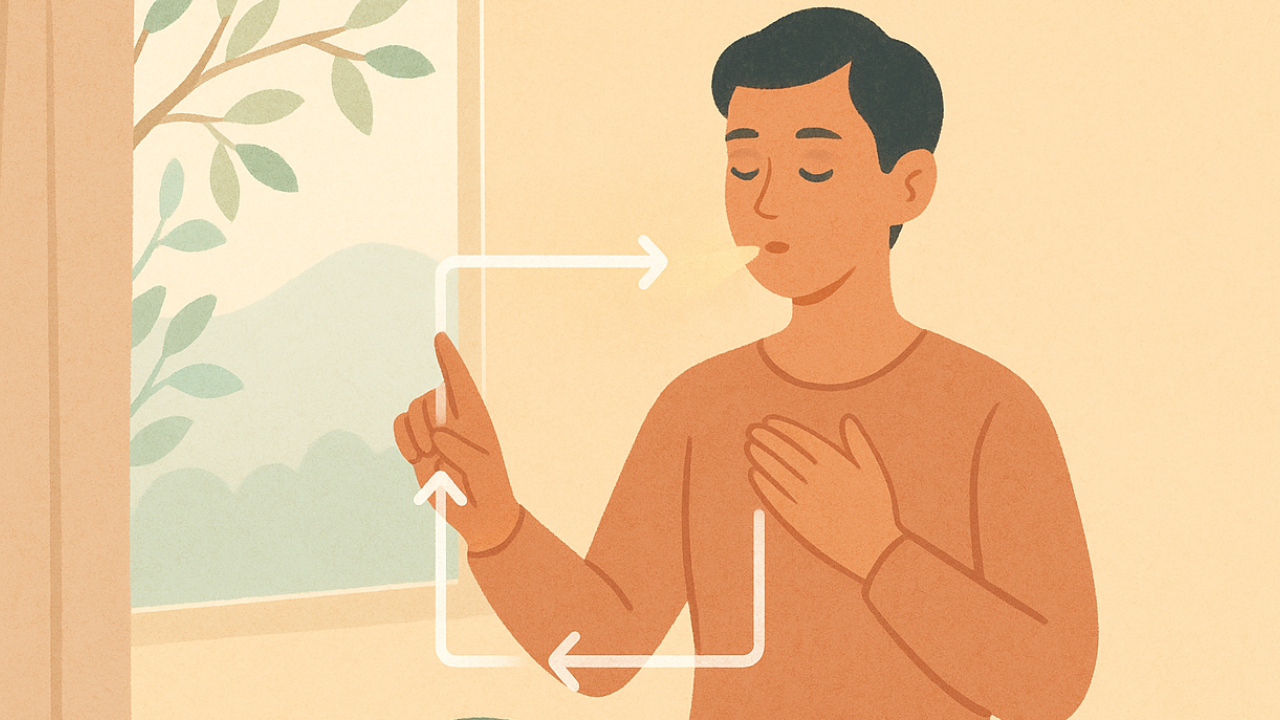
Box Breathing vs Physiological Sigh: Which Calms You Faster?
When you feel your heart race or your chest tighten, it can be hard to know what to do first.
Both box breathing and the physiological sigh are simple ways to calm your body, but they work differently depending on what your nervous system needs.
If you’re unsure which one fits you best, you can start by taking the Stress Loop Quiz to learn how your body responds under stress.
What’s the Quick Answer?
Both breathing methods may reduce anxiety, but in different ways.
- Box breathing creates balance and focus, useful for steadying yourself during daily stress.
- Physiological sighs offer faster relief, especially when you feel overwhelmed or on the edge of panic.
Let’s explore when to use each and how to tell which your body is asking for.
What Is Box Breathing?
Box breathing is a structured pattern:
Inhale 4 counts. Hold 4. Exhale 4. Hold 4.
This even rhythm helps reset your body’s natural breathing cycle and signals safety to your nervous system. It balances the sympathetic (fight-or-flight) and parasympathetic (rest-and-digest) branches.
Many people find it grounding when they feel scattered or overstimulated, similar to the steadying effect described in A 10-Minute Nervous System Reset For Overwhelm You Can Do Anywhere.
If deep breathing sometimes makes you anxious, start smaller. Try a 3-count rhythm or skip the top hold until it feels safe, like described in Why Deep Breathing Makes Me More Anxious, And What To Do Instead.
What Is the Physiological Sigh?
The physiological sigh is a natural reflex you already do when crying or releasing tension:
Take a deep inhale through the nose, then a short second sip of air, followed by a long, slow exhale through the mouth.
This technique helps release trapped carbon dioxide and relaxes the diaphragm, easing tightness in the chest or throat.
It’s a fast way to calm the body during a spike of anxiety or panic, similar to the grounding strategies in Grounding During Panic Without Talk Therapy: A Gentle Guide You Can Use Anywhere.
The physiological sigh also activates the vagus nerve, which plays a key role in restoring calm, as explored in Vagus Nerve Breathing For Trauma Recovery: Small, Kind Steps That Actually Help.
Which Is Better for Stress or Anxiety?
It depends on your state.
| Your Body Feels... | Try This |
|---|---|
| Jumpy, wired, alert | Physiological sigh (1–3 rounds) |
| Scattered or restless | Box breathing for 2–5 minutes |
| Numb or shut down | Start with small sighs, then gentle box breathing |
| Emotionally flooded | Sigh first, then slow into a box rhythm |
If you often feel “ready to jump out of your skin,” that hyper-aroused state may signal a chronic stress loop. You can read more in Why Do I Always Feel Ready To Jump Out Of My Skin For No Reason?.
For many, the best approach is combining both: one or two physiological sighs to release the pressure, then several rounds of box breathing to steady the system.
A 7-Day Mini Plan to Find Your Calm
Day 1–2: Practice one physiological sigh in the morning and one before bed.
Day 3–4: Add two minutes of box breathing after the sigh.
Day 5–7: Notice which one feels most natural and supportive.
Keep a brief note of your energy, focus, and calm afterward.
If you’re unsure, this reflective habit helps you become more attuned to your body’s feedback, like the somatic noticing described in Pendulation: A Simple Somatic Exercise to Calm Your Nervous System.
Common Sticking Points
“I get dizzy when I try to slow my breath.”
That’s your body saying it needs smaller steps. Skip the breath holds, shorten the counts, and add grounding touch, like hand on heart.
“I forget to breathe this way when I’m stressed.”
Practice when you’re calm. These techniques work best when they become muscle memory.
“I feel numb instead of calm.”
Gentle movement, hydration, or touch may help you reconnect first. See Hydration for Nervous System Regulation: How Water Helps You Feel Safe Again for simple resets.
If you’d like to understand why your body switches between “wired” and “shut down,” the Stress Loop Quiz can show which part of your nervous system leads most of your reactions—and which breathing style may help restore balance.
FAQs
1. Can I do both methods together?
Yes. A few physiological sighs followed by box breathing often gives the quickest relief and longest calm.
2. How often should I practice?
Even 2–3 minutes daily can help regulate your baseline stress response over time.
3. Can these replace therapy or medication?
No. They are supportive tools, not medical treatments. Consider talking with a professional if your anxiety feels unmanageable.
4. Can I use these when I wake up at night with racing thoughts?
Yes. The physiological sigh helps release tension fast, and box breathing helps ease back to rest, as explored in How To Calm Racing Thoughts At Night.
5. What if breathing exercises make me anxious?
Start with smaller breaths, or try somatic grounding practices instead. Vagus Nerve Massage Techniques For Beginners may help you reconnect safely.
More Gentle Reads
Disclaimer: This article is educational and not medical advice. If you have health concerns, consider speaking with a qualified professional.
Discover Your Vagal Tone
Find out how dysregulated your nervous system is and get your personalized roadmap to feeling calm, energized, and in control


